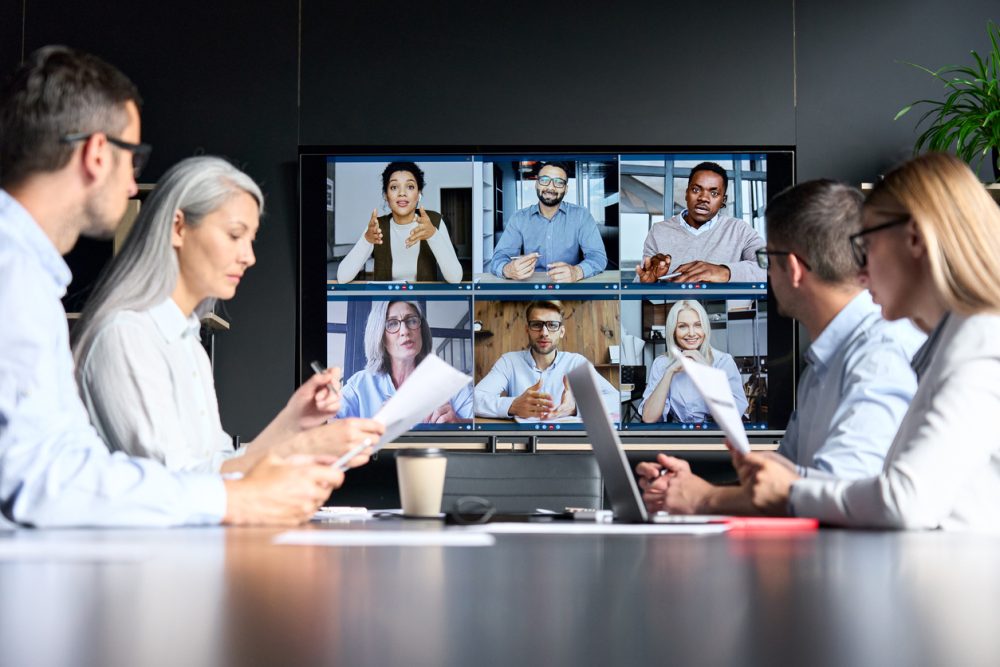As working environments evolve, consumers and businesses continue to transition from remote to hybrid work models. Gartner describes this more fluid workstyle as “anywhere operations,” and predicts that by the end of 2023, 40 percent of organizations will move to blending virtual and physical experiences for increased productivity and customer reach.
The workplace of the future will have to rely on fluid office designs, seamless connectivity, interactive tools, and immersive collaborative technologies that bring remote, mobile, and in-office staff and customers together in a way that meets the demands of the moment. Workforces will need to have technology tools that enable barrier-free access whether working at their offices, on the road, or at home.
The need for communication is stronger than ever; and businesses are challenged with bringing teams together that are in the office, working from home, or on the road. Retailers, schools, businesses, and other industries need different solutions to connect with each other and will need these solutions far into the future.
What does this mean for CE retailers, manufacturers, and customers? It means the same strategies pre-pandemic won’t work, and products need to be flexible to meet these environmental demands of the hybrid work models. Sales teams in-store, and those behind the scenes online, need to provide insights into how both B2B customers and consumers are evolving with how and where they create space. Connecting remote, mobile, and in-office team members to a more fluid and flexible approach that can adapt to any contingencies is key.
Essential office tech should include large-format, interactive collaboration displays with advanced whiteboarding software, portable USB-C enabled monitors, and intelligent webcams and microphones running over secure, IP-based networks.
- Desktop and portable monitors for productivity and virtual collaboration from home, on-the-go, in office, or any other location.
- Interactive flat-panel displays with integrated whiteboarding software that can easily transform any meeting space into a digital conference room and enable simultaneous collaboration with multiple in-house and remote teams.
- Digital signage and kiosks to enable wayfinding, contactless sign-in and visitor screening. AI-enabled monitoring to manage reception areas, protocols, and traffic flow. Manufacturers offer “health kiosks” that are stations that check on customers’ body temperature, detect mask-wearing and hold hand sanitizers at the front of the stores. Digital signage displays can communicate messaging and way-finding maps for sales and directions around the store.
- Integrated collaboration software and tools that are integral to transforming the new hybrid corporate culture. Back-end software solutions from companies such as Microsoft, Google, and Intel, among others, offer hardware manufacturers support to a complete ecosystem. A complete hardware/software ecosystem can provide metadata that helps a company understand workers’ habits in an environment so that adjustments can be made. Some examples include tracking temperatures to check on energy requirements in the store, examining occupancy levels at various times in the day, and improving customization and automation of messaging to digital signage products.
- Quick connectivity and open standards that make it simpler to transform any space, any time for any number of employees when the need arises. USB Type-C, HDMI, and other connectors, along with agnostic collaboration software, whether streaming or casting, allows multiple people, both on-site and remote, to share and communicate from a range of wired and wireless devices.Consumer electronics manufacturers have developed many products that aid in anywhere operations, especially in the last couple of years. Within physical offices, workspace will continue to be reconfigured and purpose-designed, depending on the task at hand, such as USB-C monitors that are easily redeployed when and where they are needed. Video conferencing sessions that are able to launch in minutes with minimal effort, connecting in-office and remote participants, are key to productivity, as are screens that democratize the conference room so that remote participants are equally represented and no longer a postage-size stamp on a laptop.

Significant to the new workplace is the fluidity of connecting easily from home to office, which is why portable monitors have become prevalent in many monitor portfolios. These can be used as convenient and lightweight second screens where the end-user can connect these monitors to laptops and share a screen from a distance. While a portable monitor as a second screen enhances productivity whether at home, the office, or on the road, they are limited in size.
Other portable devices include portable or PICO projectors. These allow users to share content with a larger audience while holding onto their own presentation device. Small, compact, and lightweight, projectors offer big-screen visibility that allows a distanced audience to view presentations in a conference room, coffee shop, or any blank wall.
As technologies mature and move from smartphones and mobile devices, some features are shifting automatically to other devices. The trends and technologies seem to be evolving into providing “smart,” lamp-free, and portability as primary features in today’s electronic devices. Smart and lamp-free projectors, universal connectivity options, and portability of display products are a part of that migration.
From streaming services for content or voice control functionality (Amazon Alexa and Google Assistant) and Bluetooth and Wi-Fi for wireless use, end-users are utilizing these applications both at home and in-office/conference room or classroom settings. Users stream conferences, presentations, meetings, TV shows, movies, and other content, so it’s only a natural progression in technology that the display products should incorporate both.
Retailers can offer these products for mobility and hybrid work/play environments to their customers. There seems to be a resurgence and great interest in all-in-one/multi-use products again. The line between casual home use and professional office use is practically gone, and in either environment, display products, whether monitors or projectors, need to deliver captivating pictures and sound. Features such as 4K resolution for the best image quality, great sound, and portability become key factors.
Kenneth Mau is the Director Product and Channel Marketing at ViewSonic Corp.















